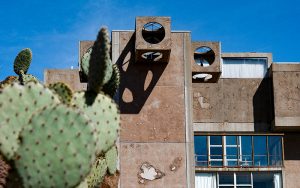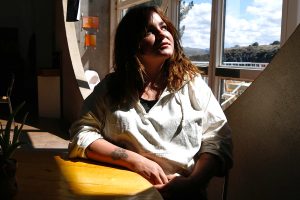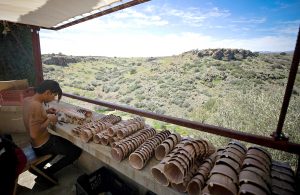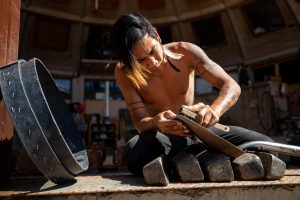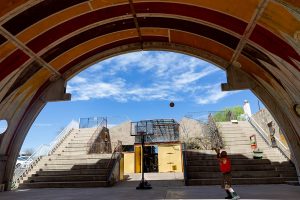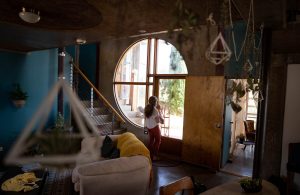- Slug: BC-CNS-Arcosanti. 3,165 words.
- 9hotos and captions below.
By LAUREN SCHIELER
Cronkite News
ARCOSANTI – At the end of a 2-mile dirt road in the Arizona desert lives a community of people longing to be a part of something bigger than themselves.
For nearly 50 years, Arcosanti has drawn innovators who wish to leave city life behind and experiment with an alternative, more sustainable lifestyle.
Some stay for a few months; some never leave.
One who never left is Mary Hoadley. She was 25 when she dropped out of graduate school in 1970, just as the project – the brainchild of architect and urban planner Paolo Soleri – was breaking ground. She was unsure what she wanted to do with her life. It was her love for architecture that attracted her to help develop Arcosanti. She planned to stay a few weeks, but the weeks turned into months and the months into years. Now 75, Hoadley has devoted most of her life to Arcosanti.
“I got captivated by the idea of going off into the desert to build a prototype alternative to sprawl,” Hoadley said. “It was as appealing 50 years ago as it is today, and as needed.”
Over the past half century, Hoadley has been among a revolving cast of residents in making simple life changes to reduce their carbon footprint.
In Arcosanti’s early years, Hoadley recalled, she tried to persuade a neighbor to compost. She planned to collect the organic waste and feed it to the chickens who roamed the campus. But they often ended up disappointed. The neighbor’s bucket of compost usually was nearly empty. Even the avocado peels that were there had been scraped clean. Few scraps were left for the birds.
That frugality was a hallmark of Hoadley’s neighbor, Soleri himself.
Man with a vision
The idea of creating a community where sustainable living was an everyday experience was only the beginning for Soleri, who was born and trained in Italy. Jeff Stein, a former resident who was one of Arcosanti’s co-presidents and now serves as the president of the Cosanti Foundation, said Soleri recognized that the consumption Americans embraced would not be healthy for the planet.
Soleri also realized that to criticize a particular lifestyle, he needed to provide a better alternative.
“The problem I am confronting is the present design of cities only a few stories high, stretching outward in unwieldy sprawl for miles,” Soleri said in 1977. “As a result, they literally transform the earth, turn farms into parking lots, wasting enormous amounts of time and energy transporting people, goods, and services over their expanses. My solution is urban implosion rather than explosion.”
The revolutionary urban laboratory he created stands as a near 50-year experiment today in the rocky desert 65 miles north of Phoenix.
Soleri attracted people of all walks of life to help cultivate his urban ideas based on the concept of arcology, which merges architecture with ecology. In time, Arcosanti was supposed to accommodate up to 5,000 people.
The land for Arcosanti was bought with a loan. Money for the project was an issue from the beginning, said Tim Bell, director of communications at Arcosanti.
“In the early days of construction, it was entirely volunteer labor out here,” Bell said.
Hoadley said Soleri “was definitely a kind of arrogant narcissist, but to work alongside him was a big lesson on how to do as much as you can with little things you had at hand.”
Stein said working on the project put you “in the thick of things.”
“There were journalists and filmmakers and broadcasters and architects and people with ideas from all over the world there on a weekly basis,” he said.
Stein was taking a break from architecture school in the 1970s when he stumbled upon the book that made Soleri famous, “Arcology: The City in the Image of Man.”
“I called the Cosanti Foundation (created to support the development of Arcosanti) and talked to Paolo Soleri’s wife, who said they had this workshop program at Arcosanti if I was interested,” Stein recalled. “It turned out I was.”
Stein arrived in 1976 and stayed seven years.
Soleri’s idea for Arcosanti was not outlandish for its time, he said.
“All sorts of fantastic things were happening,” Stein said. “The end of the Vietnam War, the landing of a man on the moon, for heaven’s sake. The first Earth Day was 1970. It was a time when we thought that anything was possible. To reconfigure the entirety of Earth’s urban civilization in a way that might make sense seemed natural.”
Stein became a co-president in 2011, after Soleri resigned at age 91.
“Soleri thought if we could be better humans than we were, then we are going to need an architecture that supports that, and that’s what Arcosanti started to become,” Stein said.
Soleri began cultivating an environment that prioritized sustainable living and social interaction, but Arcosanti residents weren’t completely disconnected from the conveniences of modern-day living.
“People in Arcosanti own cars,” Stein said. “I owned a car. I owned a motorcycle. I almost never used them because all of the work was right there. I could walk to a cafe. I could walk to a foundry. I was connected to a greenhouse. I didn’t have a heating system in my apartment. Instead I had a solar greenhouse so I could go out and pick food for my lunch.”
Hoadley puts it this way: “For Soleri, he always had this strong sense in equity and justice, that whatever you do, all human beings should have access to that same benefit.”
Today, a cafe serves breakfast, lunch and dinner at Arcosanti. There are a dozen rooms for overnight guests, a place that can be rented through Airbnb and a venue that serves as a place for concerts and weddings. Arcosanti also has its own IT department that oversees a website, a Wi-Fi network, a guest-services department and people who work in graphic design and tourism.
A place to find purpose
Over the years, Stein said, about 8,000 people have participated in workshops, internships and residency programs. And thousands of visitors from all over the globe have stopped to explore Soleri’s grand experiment.
For the nearly 80 residents who live here, though, Arcosanti is their home.
Madeline Visser, 30, was working in Salt Lake City when a friend told her about Arcosanti.
“Everyone has a different background of how they end up here,” she said. “Most people come because they’re architect students. I’m not an architect. I didn’t think that I would have a place here.”
When Visser tried a workshop, she worked in the cafe to pay for tuition. After a few months, she had fallen in love with the community and decided to stay. For the past six months, Visser has made clay bells in the ceramics department.
“I never pictured myself living in Arizona with the open desert, but the sense of community that happens here is very beautiful,” Visser said. “I just found a lot of potential in myself here. There’s such a wealth of knowledge here too. There are so many well-educated people here, you can learn so many different crafts and skills.”
The experience and sense of community has given Visser a new outlook on life.
“When I was in the city, I never wanted to be home alone,” she said. “I’d always want to be going out. Here, I’m more mindful of what my intentions are for that day.”
Visser said she plans to stay for another year or two, but whenever she leaves, she’s grateful she’ll always be able to call Arcosanti home.
“It’s what pushed me out of my comfort zone, and I’m ready to keep chasing that feeling.”
For Stein, Arcosanti was also more than just a temporary workshop.
“It was what I thought college ought to be like,” Stein said. “We were learning on the job.”
Outside of work, he said, living on-site was incredible.
“My apartment was in the back wall of a theater,” Stein said. “I could go out my front door and be in the midst of culture. I could go out my back door and be in the untouched desert.”
He eventually left to finish architecture school and went on to become an architect, professor and architect critic for a Boston newspaper.
Bell, Arcosanti’s communications director, was living in Queens, New York, trying to become an actor, but when his father’s health started to decline, he moved to Arizona to help with his care. Bell heard about Arcosanti from a bartender, and after exploring the place for himself, he opened his mind to an alternative to living in a city.
“I didn’t know that I was looking for an alternative, but when I came to experience it, I knew this was a really special place and I needed to find a way to live here,” said Bell, who has lived at Arcosanti for a year and a half.
The pushback
The Arcosanti experiment has received its fair share of criticism from architects and visitors.
Mark English who owns an architecture firm in San Francisco, visited Arcosanti for the first time last spring. He had wanted to explore the community since his friends in college raved about serving internships at Arcosanti in the mid-1980s, but the project was “shockingly disappointing.”
“When I pulled up, I thought, ‘What a sad place,” English said.
English said his expectations were built on glowing descriptions of Arcosanti in books he had read and his friends’ enthusiasm, but he noticed flaws within minutes of exploring the property. The first was the sound of a hidden air-conditioning unit and the lack of natural shading in the design.
“Here in the middle of the desert we have a building that has no shade structures on any facade,” English said. “It’s basic structure is such that it has to be air-conditioned. In its very form, it’s wrong. It’s falling apart. It’s irredeemable.”
English said Soleri failed to pay attention to working with the desert environment and instead made an architectural object statement rather than a revolutionary town.
“Cultures that don’t have excessive amounts of wealth and energy to waste can’t make those mistakes, but he could.”
Yes, the models of the overall project are fantastic, English said, but the execution was not funded properly or properly articulated.
“I looked so hard to find anything that would convince me that it was a worthwhile experiment,” English said. “I couldn’t find anything.”
However, the project could have had potential, he said.
“It’s a very sexy idea to create a new society in the middle of a desert,” English said, but Soleri’s vision was faulty from the beginning.
“It was an expression of one of those outlandish fantasies from a middle-aged white male about being a hero,” English said. “The laboratory could have been an expression of how to build in a harsh environment in a way that used very little energy.”
Arcosanti residents recognize the project is an experiment.
“I don’t think Soleri would have ever argued that it was the be all, end all of ideas,” Bell said.
But for many, despite the challenges, they were proud to be a part of a possible solution.
“The process was what was satisfying, so even if you don’t get to the end goal, it’s the process that’s really important,” Hoadley said. ‘Soleri didn’t feel a shrink to criticize unless he could offer something different.”
Challenges in the desert
Soleri believed in the work he was doing, but his project was not easy and progressed slowly.
“When he was still around,” said Hoadley, his former neighbor, “Soleri would sometimes say if he knew it was going to be such a slug and slow-going project, he didn’t know if he would’ve started.”
Hoadley also wishes her generation had done more.
“I’m kind of disappointed in my generation,” Hoadley said.
The generation that’s slowly taking over the project also have noticed a few bumps along the path.
“We don’t have the permits to do the things we’ve done in the past,” Visser said. “Most of the construction was done within the first 10 years of being built, but I feel like the past 20 years has been a bit stagnant. It requires a lot of money to keep this project going.”
For example, paving the 2-mile dirt road to the site is a multimillion dollar project.
Visser also said Arcosanti took a hit after the most recent recession.
“It’s been quite stagnant,” she said. “There’s not as many people are coming through, not as much is happening, and people are comfortable with how it’s been.”
Another problem, Bell said, is that many residents leave because they can’t earn working for the nonprofit to fund a retirement account.
And though some residents view the sense of community as a strength, this can also be a challenge.
“The size of the community is the main reason people leave,” Bell said. “At the end of the day, it’s the same 70 people who live here.”
A respected inventor; an abusive father
As Soleri was battling the challenges that came with a project of this scale, he was dealing with personal failures.
In 2017, Soleri’s daughter Daniela Soleri released an open letter titled “Sexual abuse: It’s you, him and his work” in which she leveled assault allegations against her father.
“In my early adolescence, my father, an architect and craftsman, began sexually molesting me, eventually attempting rape when I was 17,” she wrote.
Hoadley, who worked alongside Soleri for years before his death in 2013, believes his personal life and architectural achievements must be viewed separately.
“He was not a good father to his daughter,” she said. “To me, he was a human being. He was narcissistic. A lot of very genius people don’t recognize the normal boundaries of social behavior. You have to separate the two. We’re all human. We all have flaws.”
Soleri also struggled with self-confidence, Stein said.
“He was a self-deprecating guy,” Stein said. “He thought that the work he was doing was extremely important, but he himself not so much.”
In her letter, Daniela Soleri said the value of his accomplishments is diminished by his behavior.
“I have tested myself over the last years, looking hard at Soleri’s artistic and architectural work,” she wrote. “Most does not seem to me to be compromised by his worst behaviors.”
Soleri was 93 when he died April 9, 2013, at his home in Paradise Valley.
Many wondered whether the death of the man would mean the death of the vision, but Arcosanti residents knew there was still work to be done.
“After Soleri passed, there was still a commitment to carrying on,” Hoadley said. “The place has an incredible sense of community.”
Bell said four longtime residents took up executive positions to take control of the site when Soleri died.
“That co-president system worked well as an interim system, but it was never a model for growth,” Bell said. Last year, the board of directors hired a CEO to help.
“There has kind of been this long understanding here that the site would be fine no matter what we would find a way to make it work,” Bell said.
Decades of lessons
After nearly 50 years of living on-site, Hoadley doesn’t regret her decision to be part of Arcosanti.
“Suburbia is essentially just a big hermitage where everybody’s in their four walls with their automobiles,” she said. “They don’t even interact even with their real environment let alone their landscape environment. They don’t really interact with their neighbors. There’s no integrated sense of community.”
For newer residents, like Visser, Arcosanti has been a wealth of knowledge.
“I don’t have the background to learn these things, but I can because I have a willingness to learn,” she said. “I can build myself a shelter if needed.”
Visser said city life led her to surround herself with people exactly like herself, and Arcosanti forces her to get along with people from all walks of life who have all come together for the greater good.
“If everyone on the planet lived in the same way we live in the developed Western world right now, we’d need three and a half globes to sustain our current global population,” Bell said.
After living in New York and Arcosanti, Bell has experienced a shift.
“Even on a bad day here, it’s still a pretty good day for the most part,” Bell said. “For some people it’s actually really nice because they have really strong boundaries around their work, live life.”
Bell said that there is a design flaw in the way that Americans build their environments.
“We don’t encourage people to communicate and collaborate; we encourage them to consume and compete,” Bell said. “There is an unfortunate irony to the idea that as we’ve packed our populations more densely, we’ve actually become a lot more distant with one another.”
Paradoxically, Arcosanti – although practically in the middle of nowhere – has served as an escape from isolation and a place to become involved in a community.
“The whole idea was to capture the attention and imagination of a generation to think about a different way for people to live on the planet in a way where all people have access to a healthy life instead of the wealthy few who get the penthouses and it’s on the backs of millions of the world’s population,” Hoadley said.
The next 50 years
Despite the death of Soleri and the challenges Arcosanti has faced, residents aren’t worried about the project’s future.
“Humans are always looking to be a part of something bigger than themselves,” Hoadley said. “I feel privileged and proud to have been part of this. After 50 years, these ideas which we’re trying to work on are very simple.”
At the core of this idea is building communities that are vertical rather than sprawl out across the desert.
Today, Arcosanti may not be sparking revolutionary change worldwide. But for residents, that’s not the mission.
“Arcosanti really just wants to be a walk through demonstration that can inspire people to maybe make better choices,” Hoadley said.
“We don’t know if this is a good or a bad idea.” Bell said. “We’re part of a larger web of conversation around what holistic planning or holistic living on the planet is going to look like going forward,” Bell said.
The mission will continue and Arcosanti will stand as an example for an alternative lifestyle.
“The mission has always been to explore the experiential benefits of combining architecture with ecology,” Bell said. “Explore the experiential and educational benefits of combining architecture and ecology. That’s why we call it an urban laboratory.”
Cronkite News reporter Kelsey Mo contributed to this story.
This story is part of Elemental: Covering Sustainability, a new multimedia collaboration between Cronkite News, Arizona PBS, KJZZ, KPCC, Rocky Mountain PBS and PBS SoCal.
For more stories from Cronkite News, visit cronkitenews.azpbs.org.
^_=
